Acura MDX 2017 Owner's Guide
Manufacturer: ACURA, Model Year: 2017, Model line: MDX, Model: Acura MDX 2017Pages: 170, PDF Size: 12.43 MB
Page 151 of 170
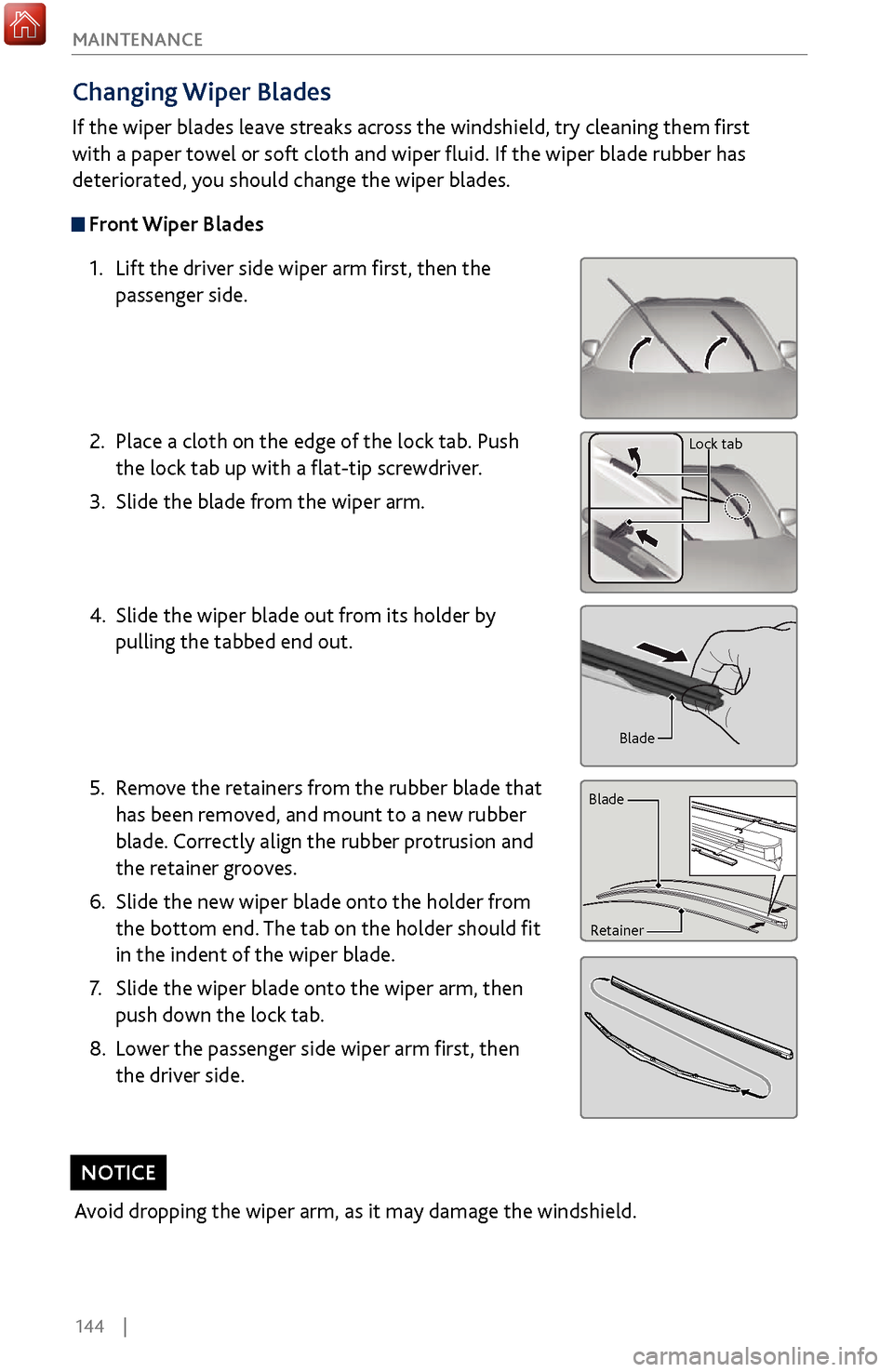
144 |
MAINTENANCE
Changing Wiper Blades
If the wiper blades leave streaks across the windshield, try cleaning them first
with a paper towel or soft cloth and wiper fluid. If the wiper blade rubber has
deteriorated, you should change the wiper blades.
Front Wiper Blades
1.
Lift the driver side
wiper arm first, then the
passenger side.
2.
Place a cloth on the
edge of the lock tab. Push
the lock tab up with a flat-tip screwdriver.
3.
Slide the blade fr
om the wiper arm.
4.
Slide the wiper blade
out from its holder by
pulling the tabbed end out.
5.
Remov
e the retainers from the rubber blade that
has been removed, and mount to a new rubber
blade. Correctly align the rubber protrusion and
the retainer grooves.
6.
Slide the new wiper
blade onto the holder from
the bottom end. The tab on the holder should fit
in the indent of the wiper blade.
7.
Slide the wiper blade onto the
wiper arm, then
push down the lock tab.
8.
Lower the passenger side wiper arm
first, then
the driver side.
Lock tab
Blade
Retainer
Blade
Avoid dropping the wiper arm, as it may damage the windshield.
NOTICE
Page 152 of 170

| 145
MAINTENANCE
Rear Wiper Blade
1.
Raise the wiper arm off the
window.
2.
Slide the wiper blade out
from the end with the
indent.
3.
Remov
e the retainers from the wiper blade and
mount to a new rubber blade.
4.
Slide the wiper blade
onto the holder. Make sure
it is engaged correctly, then install the wiper
blade assembly onto the wiper arm.
Blade
Retainer
Rubber
Page 153 of 170
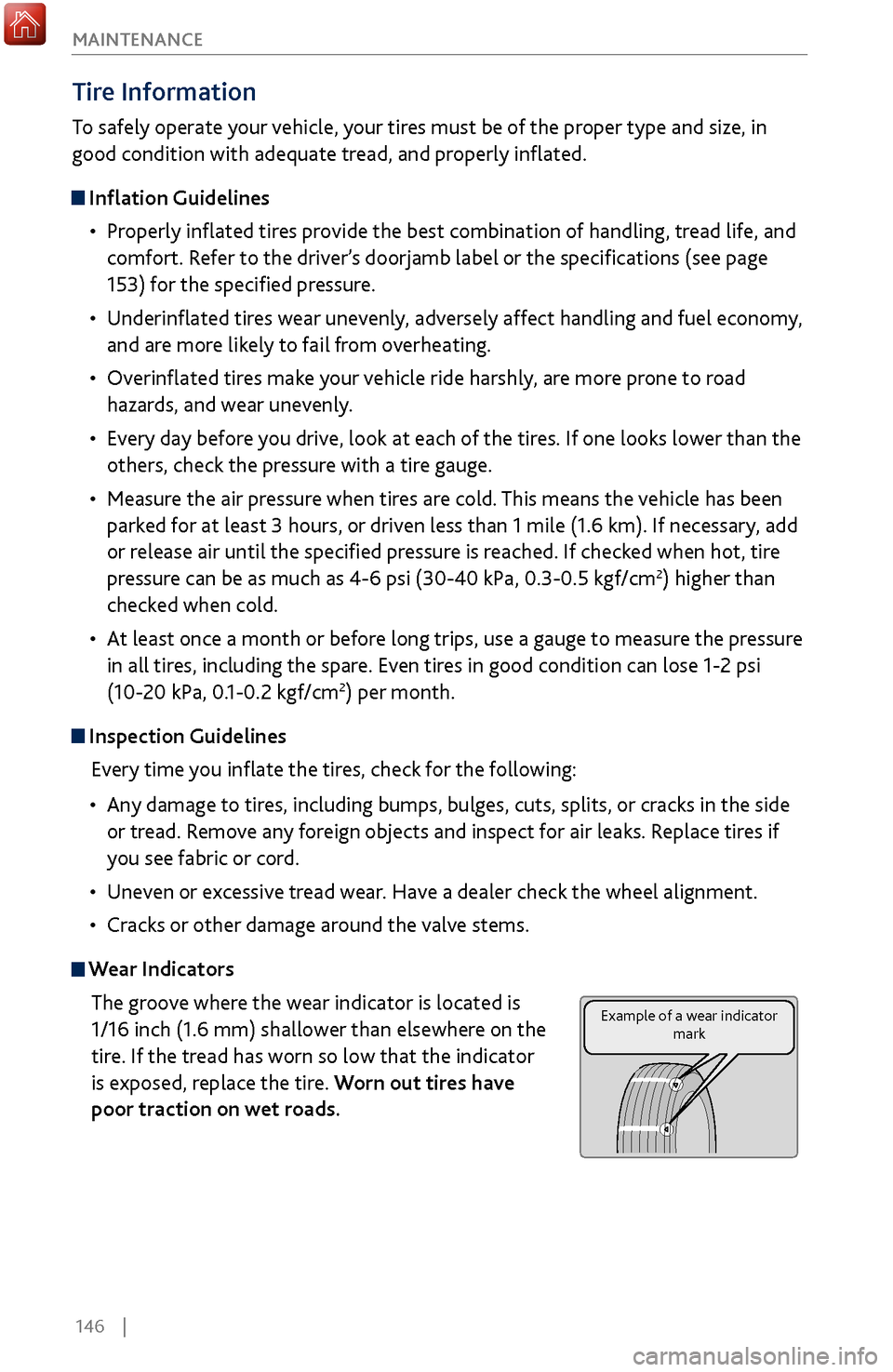
146 |
MAINTENANCE
Tire Information
To safely operate your vehicle, your tires must be of the proper type and size, in
good condition with adequate tread, and properly inflated.
Inflation Guidelines
•
Properly inflated
tires provide the best combination of handling, tread life, and
comfort. Refer to the driver’s doorjamb label or the specifications (see page
153) for the specified pressure.
•
Underinflated tires
wear unevenly, adversely affect handling and fuel economy,
and are more likely to fail from overheating.
•
Overinflated tir
es make your vehicle ride harshly, are more prone to road
hazards, and wear unevenly.
•
Every day befor
e you drive, look at each of the tires. If one looks lower than the
others, check the pressure with a tire gauge.
•
Measure the air pr
essure when tires are cold. This means the vehicle has been
parked for at least 3 hours, or driven less than 1 mile (1.6 km). If necessary, add
or release air until the specified pressure is reached. If checked when hot, tire
pressure can be as much as 4-6 psi (30-40 kPa, 0.3-0.5 kgf/cm
2) higher than
checked when cold.
•
At least once a month
or before long trips, use a gauge to measure the pressure
in all tires, including the spare. Even tires in good condition can lose 1-2 psi
(10-20 kPa, 0.1-0.2 kgf/cm
2) per month.
Inspection Guidelines
Every time you inflate the tires, check for the following:
•
Any damage
to tires, including bumps, bulges, cuts, splits, or cracks in the side
or tread. Remove any foreign objects and inspect for air leaks. Replace tires if
you see fabric or cord.
•
Uneven or ex
cessive tread wear. Have a dealer check the wheel alignment.
•
Cracks or other damage around the
valve stems.
Wear IndicatorsThe groove where the wear indicator is located is
1/16 inch (1.6 mm) shallower than elsewhere on the
tire. If the tread has worn so low that the indicator
is exposed, replace the tire. Worn out tires have
poor traction on wet roads.
Example of a wear indicator mark
Page 154 of 170
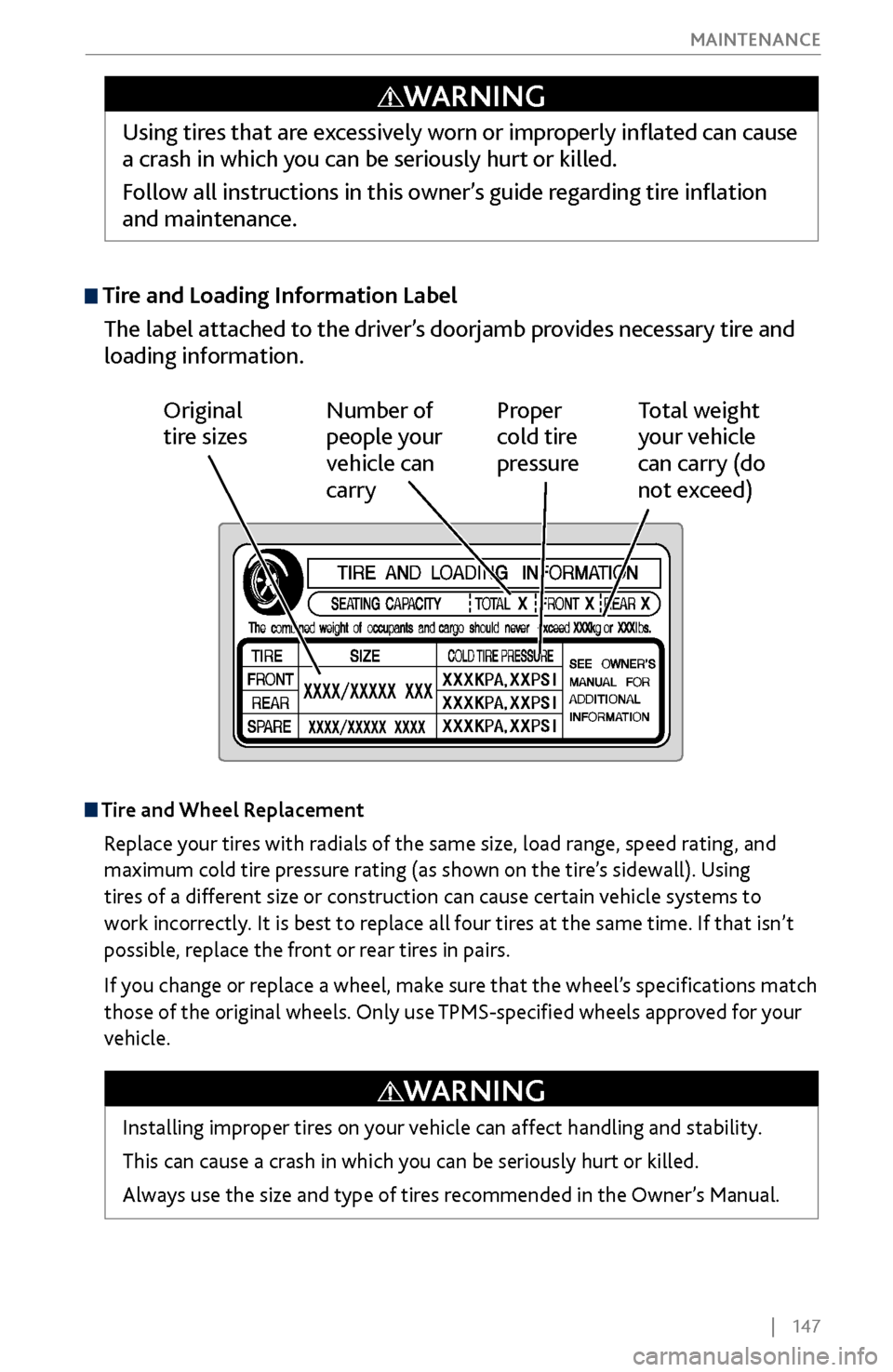
| 147
MAINTENANCE
Tire and Loading Information Label
The label attached to the driver’s doorjamb provides necessary tire and
loading information.
Original
tire sizes Number of
people your
vehicle can
carry Proper
cold tire
pressure
Total weight
your vehicle
can carry (do
not exceed)
Tire and Wheel Replacement
Replace your tires with radials of the same size, load range, speed rating, and
maximum cold tire pressure rating (as shown on the tire’s sidewall). Using
tires of a different size or construction can cause certain vehicle systems to
work incorrectly. It is best to replace all four tires at the same time. If that isn’t
possible, replace the front or rear tires in pairs.
If you change or replace a wheel, make sure that the wheel’s specifications match
those of the original wheels. Only use TPMS-specified wheels approved for your
vehicle.
Using tires that are excessively worn or improperly inflated can cause
a crash in which you can be seriously hurt or killed.
Follow all instructions in this owner’s guide regarding tire inflation
and maintenance.
WARNING
Installing improper tires on your vehicle can affect handling and stability.
This can cause a crash in which you can be seriously hurt or killed.
Always use the size and type of tires recommended in the Owner’s Manual.
WARNING
Page 155 of 170
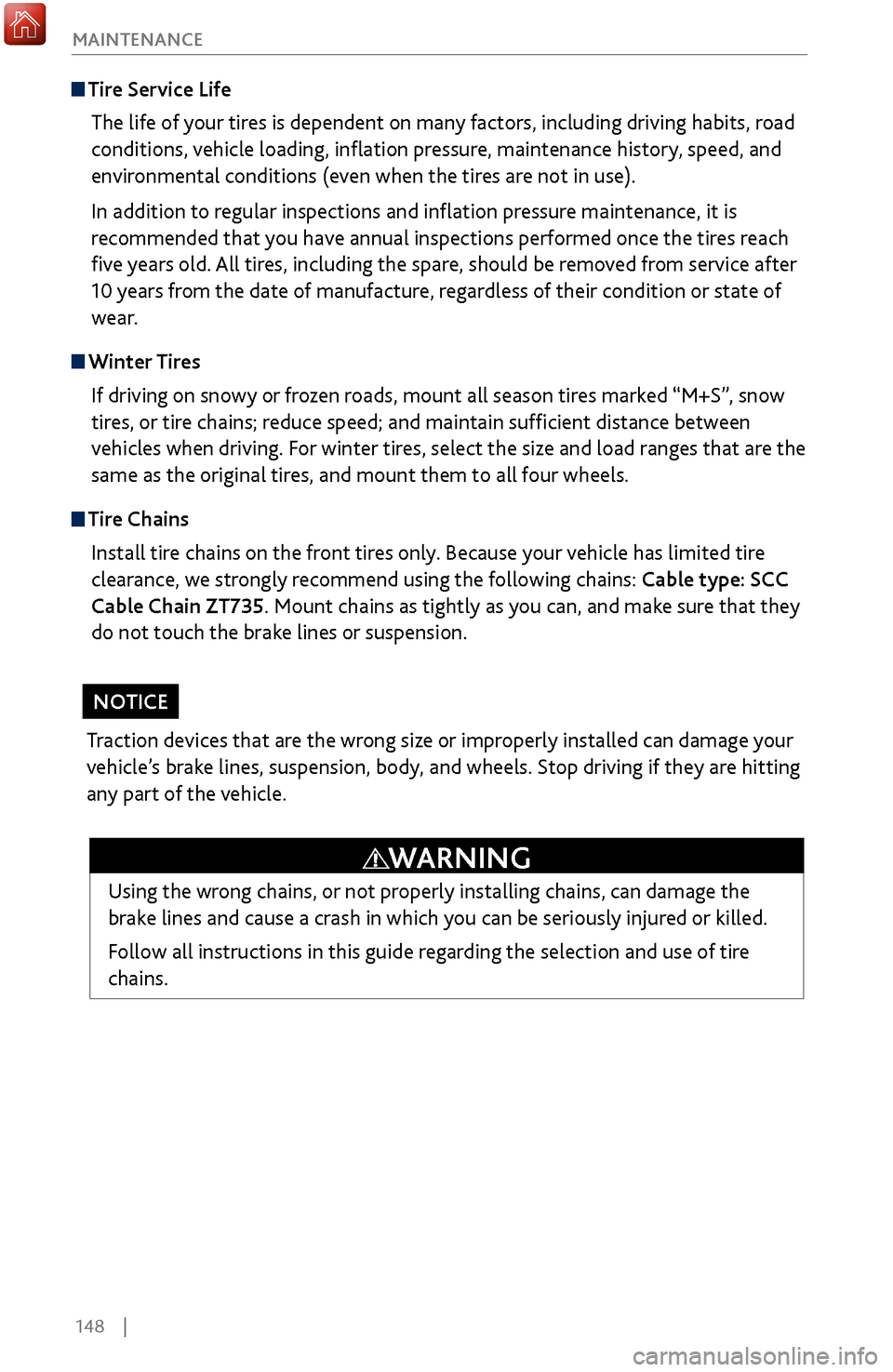
148 |
MAINTENANCE
Tire Service Life
The life of your tires is dependent on many factors, including driving habits, road
conditions, vehicle loading, inflation pressure, maintenance history, speed, and
environmental conditions (even when the tires are not in use).
In addition to regular inspections and inflation pressure maintenance, it is
recommended that you have annual inspections performed once the tires reach
five years old. All tires, including the spare, should be removed from service after
10 years from the date of manufacture, regardless of their condition or state of
wear.
Winter Tires
If driving on snowy or frozen roads, mount all season tires marked “M+S”, snow
tires, or tire chains; reduce speed; and maintain sufficient distance between
vehicles when driving. For winter tires, select the size and load ranges that are the
same as the original tires, and mount them to all four wheels.
Tire Chains
Install tire chains on the front tires only. Because your vehicle has limited tire
clearance, we strongly recommend using the following chains: Cable type: SCC
Cable Chain ZT735. Mount chains as tightly as you can, and make sure that they
do not touch the brake lines or suspension.
Using the wrong chains, or not properly installing chains, can damage the
brake lines and cause a crash in which you can be seriously injured or killed.
Follow all instructions in this guide regarding the selection and use of tire
chains.
WARNING
Traction devices that are the wrong size or improperly installed can damage your
vehicle’s brake lines, suspension, body, and wheels. Stop driving if they are hitting
any part of the vehicle.
NOTICE
Page 156 of 170
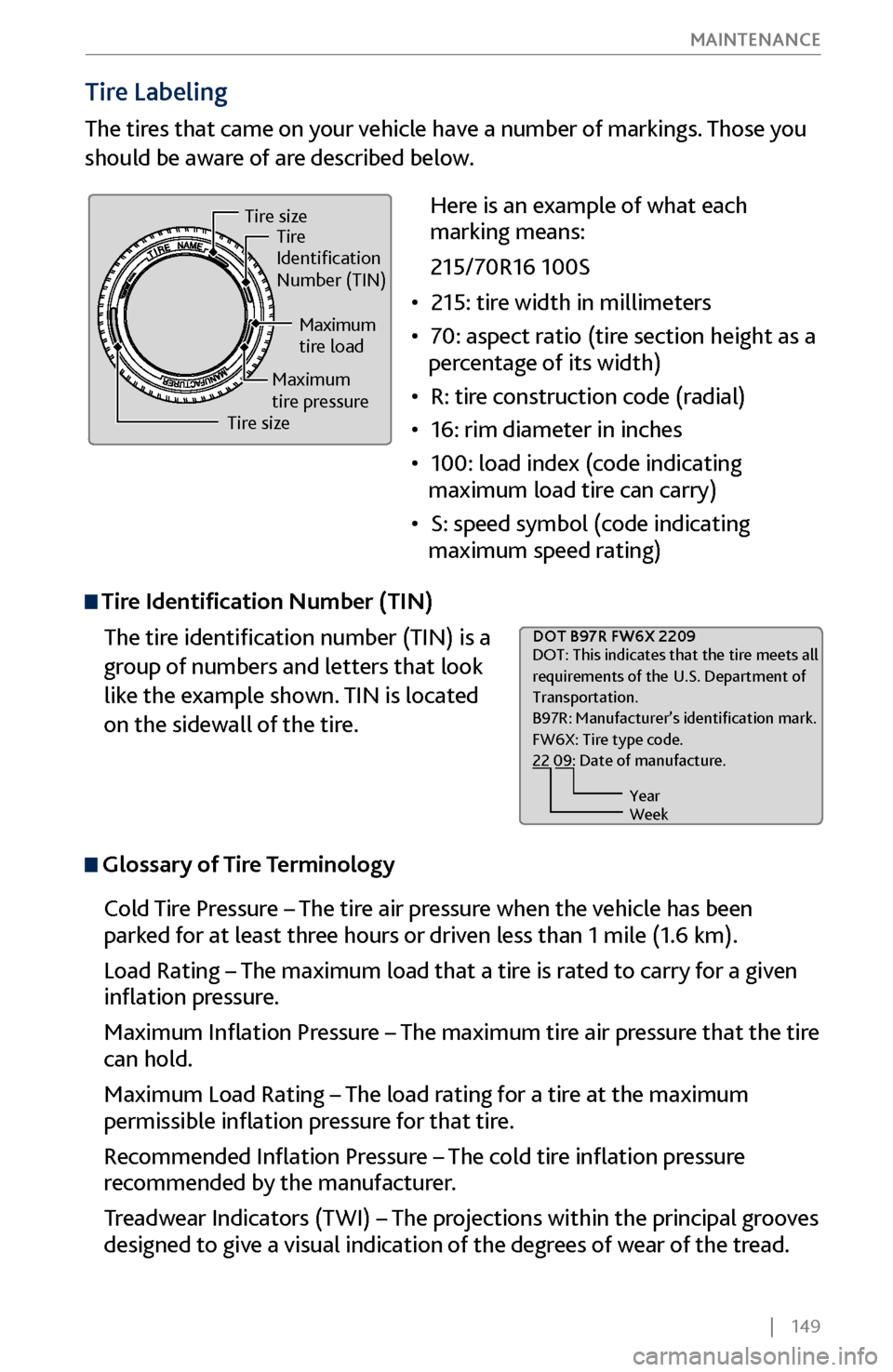
| 149
MAINTENANCE
Tire Labeling
The tires that came on your vehicle have a number of markings. Those you
should be aware of are described below.
Tire Identification Number (TIN)
The tire identification number (TIN) is a
group of numbers and letters that look
like the example shown. TIN is located
on the sidewall of the tire.
Glossary of Tire Terminology
Cold Tire Pressure – The tire air pressure when the vehicle has been
parked for at least three hours or driven less than 1 mile (1.6 km).
Load Rating – The maximum load that a tire is rated to carry for a given
inflation pressure.
Maximum Inflation Pressure – The maximum tire air pressure that the tire
can hold.
Maximum Load Rating – The load rating for a tire at the maximum
permissible inflation pressure for that tire.
Recommended Inflation Pressure – The cold tire inflation pressure
recommended by the manufacturer.
Treadwear Indicators (TWI) – The projections within the principal grooves
designed to give a visual indication of the degrees of wear of the tread.
DO T B97R FW6X 2209
DOT: This indicates that the tire meets all
requirements of the U.S. Department of
Transportation.
B97R: Manufacturer’s identi�cation mark.
FW6X: Tire type code.
22 09: Date of manufacture.
Year
Week
Here is an example of what each
marking means:
215/70R16 100S
•
215: tire
width in millimeters
•
70: aspect ratio (tire section height as a
per
centage of its width)
•
R: tire construction code (radial)
•
16: rim diameter in inches
•
100: load index (code indicating
maximum load tire can carry)
•
S: speed symbol (code indicating
maximum speed rating)
Tire size Tire
Identi�cation
Number (TIN)
Maximum
tire load
Maximum
tire pressure
Tire size
Page 157 of 170
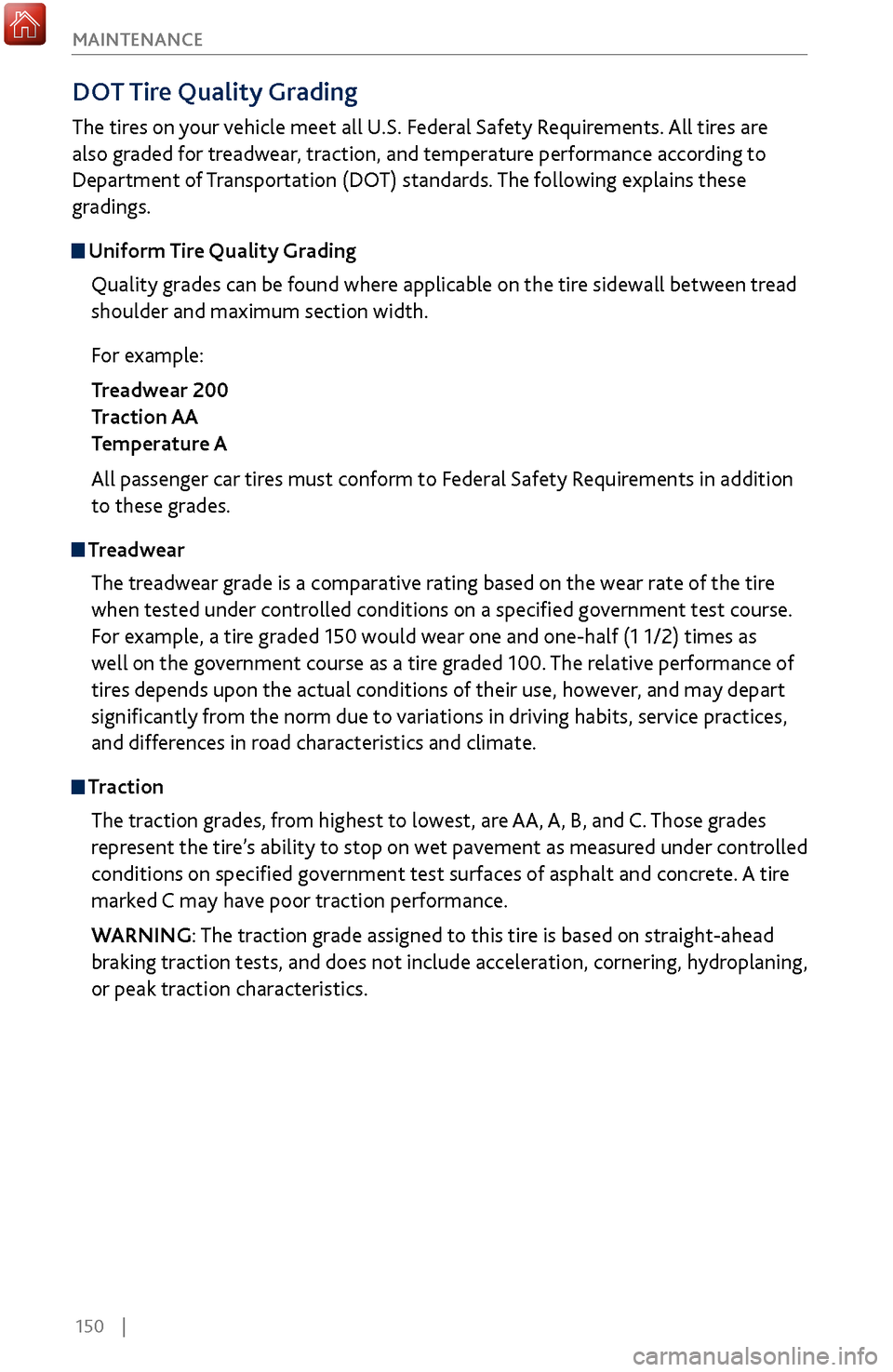
150 |
MAINTENANCE
DOT Tire Quality Grading
The tires on your vehicle meet all U.S. Federal Safety Requirements. All tires are
also graded for treadwear, traction, and temperature performance according to
Department of Transportation (DOT) standards. The following explains these
gradings.
Uniform Tire Quality Grading
Quality grades can be found where applicable on the tire sidewall between tread
shoulder and maximum section width.
For example:
Treadwear 200
Traction AA
Temperature A
All passenger car tires must conform to Federal Safety Requirements in addition
to these grades.
TreadwearThe treadwear grade is a comparative rating based on the wear rate of the tire
when tested under controlled conditions on a specified government test course.
For example, a tire graded 150 would wear one and one-half (1 1/2) times as
well on the government course as a tire graded 100. The relative performance of
tires depends upon the actual conditions of their use, however, and may depart
significantly from the norm due to variations in driving habits, service practices,
and differences in road characteristics and climate.
TractionThe traction grades, from highest to lowest, are AA, A, B, and C. Those grades
represent the tire’s ability to stop on wet pavement as measured under controlled
conditions on specified government test surfaces of asphalt and concrete. A tire
marked C may have poor traction performance.
WARNING: The traction grade assigned to this tire is based on straight-ahead
braking traction tests, and does not include acceleration, cornering, hydroplaning,
or peak traction characteristics.
Page 158 of 170

| 151
MAINTENANCE
Temperature
The temperature grades are A (the highest), B, and C, representing the tire’s
resistance to the generation of heat and its ability to dissipate heat when
tested under controlled conditions on a specified indoor laboratory test wheel.
Sustained high temperature can cause the material of the tire to degenerate and
reduce tire life, and excessive temperature can lead to sudden tire failure. The
grade C corresponds to a level of performance which all passenger car tires must
meet under the Federal Motor Vehicle Safety Standard No. 109. Grades B and
A represent higher levels of performance on the laboratory test wheel than the
minimum required by law.
WARNING: The temperature grade for this tire is established for a tire that
is properly inflated and not overloaded. Excessive speed, underinflation, or
excessive loading, either separately or in combination, can cause heat buildup
and possible tire failure.
Page 159 of 170
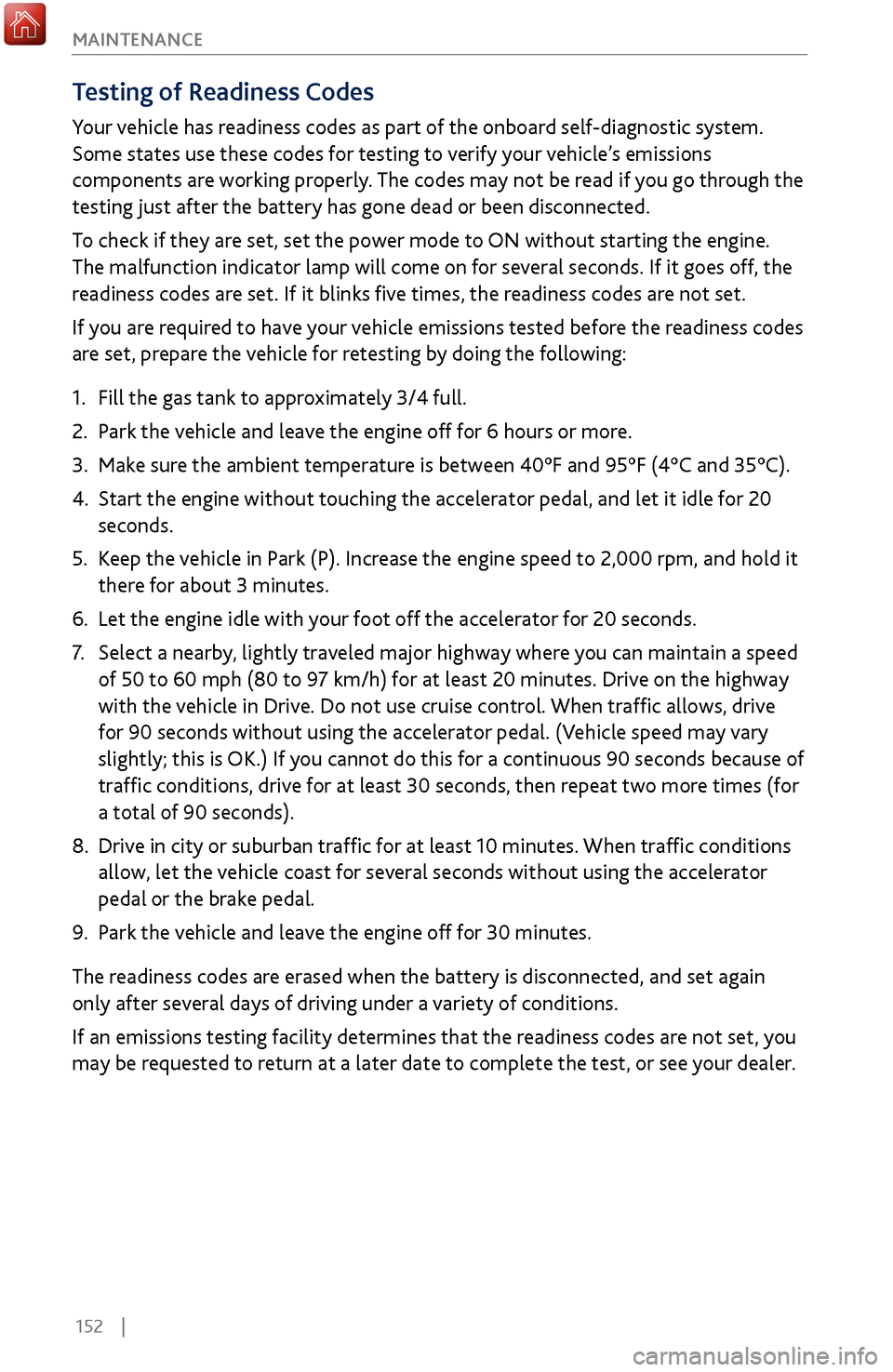
152 |
MAINTENANCE
Testing of
Readiness Codes
Your vehicle has readiness codes as part of the onboard self-diagnostic system.
Some states use these codes for testing to verify your vehicle’s emissions
components are working properly. The codes may not be read if you go through the
testing just after the battery has gone dead or been disconnected.
To check if they are set, set the power mode to ON without starting the engine.
The malfunction indicator lamp will come on for several seconds. If it goes off, the
readiness codes are set. If it blinks five times, the readiness codes are not set.
If you are required to have your vehicle emissions tested before the readiness codes
are set, prepare the vehicle for retesting by doing the following:
1.
Fill the gas tank to appr
oximately 3/4 full.
2.
Park the
vehicle and leave the engine off for 6 hours or more.
3.
Make sure
the ambient temperature is between 40°F and 95°F (4°C and 35°C).
4.
Start the engine without
touching the accelerator pedal, and let it idle for 20
seconds.
5.
Keep the
vehicle in Park (P). Increase the engine speed to 2,000 rpm, and hold it
there for about 3 minutes.
6.
Let the engine idle with
your foot off the accelerator for 20 seconds.
7.
Select a nearby, lightl
y traveled major highway where you can maintain a speed
of 50 to 60 mph (80 to 97 km/h) for at least 20 minutes. Drive on the highway
with the vehicle in Drive. Do not use cruise control. When traffic allows, drive
for 90 seconds without using the accelerator pedal. (Vehicle speed may vary
slightly; this is OK.) If you cannot do this for a continuous 90 seconds because of
traffic conditions, drive for at least 30 seconds, then repeat two more times (for
a total of 90 seconds).
8.
Drive in city or suburban
traffic for at least 10 minutes. When traffic conditions
allow, let the vehicle coast for several seconds without using the accelerator
pedal or the brake pedal.
9.
Park the
vehicle and leave the engine off for 30 minutes.
The readiness codes are erased when the battery is disconnected, and set again
only after several days of driving under a variety of conditions.
If an emissions testing facility determines that the readiness codes are not set, you
may be requested to return at a later date to complete the test, or see your dealer.
Page 160 of 170
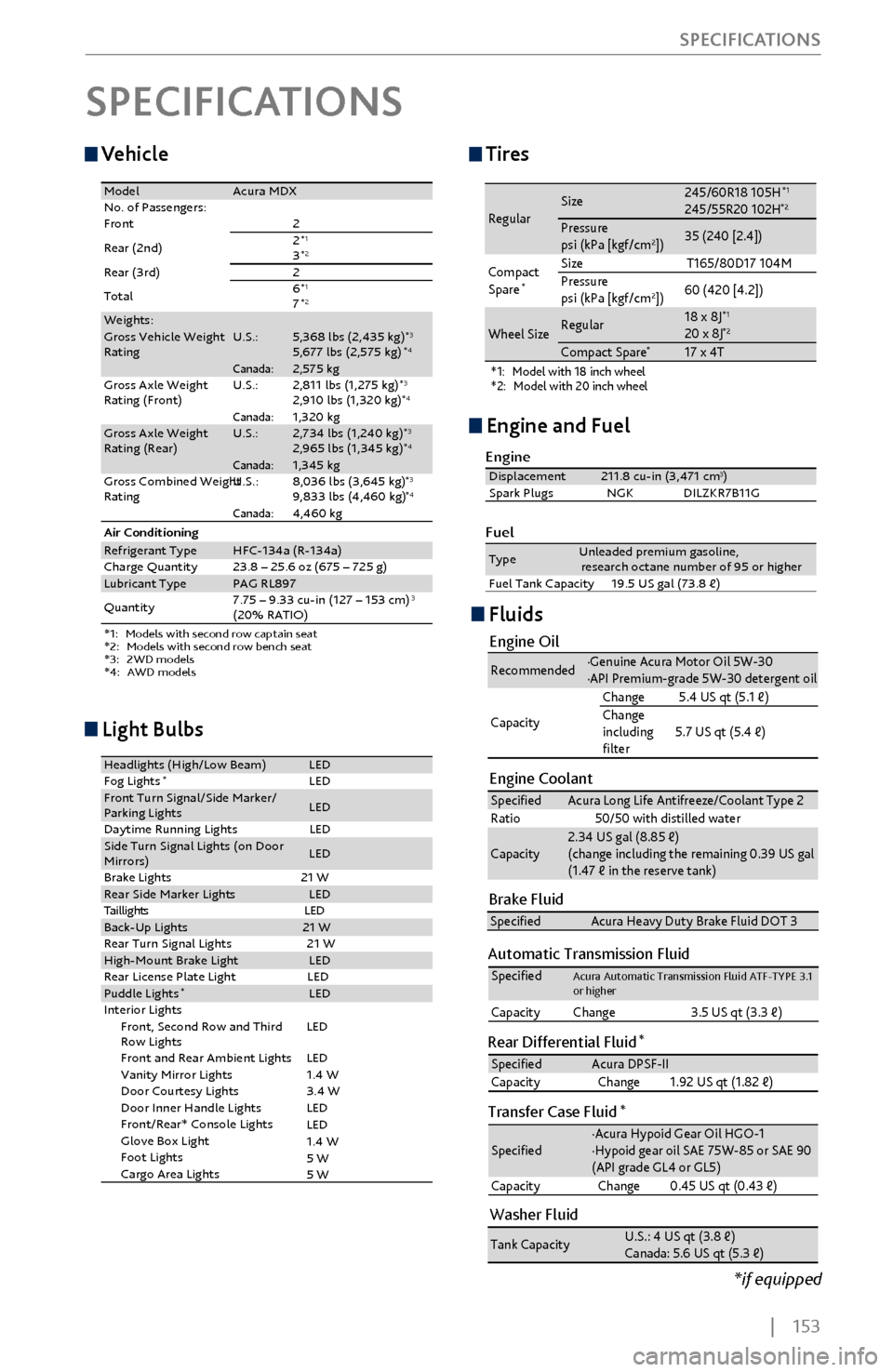
| 153
SPECIFICATIONS
Vehicle
*
*
1: Models with second row captain seat
* 2: Models with second row bench seat
* 3: 2WD models
4: AWD models
ModelAcura MDX
Front No. of Passengers: 2
12*
2Rear (2nd) 3*2
Rear (3rd)1Tota l 6*
27*Weights:
RatingGross Vehicle Weight U.S.:5,368 lbs (2,435 kg)*3
Gross Axle Weight 5,677 lbs (2,575 kg
)
*4Canada:2,575 kg
Rating (Front)U.S.: 2,811 lbs (1,275 kg)*3
Gross Axle Weight 2,910 lbs (1,320 kg
)
*4Canada:1,320 kg
Rating (Rear)U.S.: 2,734 lbs (1,240 kg)*3
Gross Combined Weight
Rating U.S.
: 2,965 lbs (1,345 kg)
*4Canada
:1,345 kg
8,036 lbs (3,645 kg )*39,833 lbs (4,460 kg)*4Canada:4,460 kg
Refrigerant Type
Charge Quantity
Lubricant TypeQuantity
HFC-134a (R-134a )
23.8 – 25.6 oz (675 – 725 g )
PAG RL89 7
7.75 – 9.33 cu-in (127 – 153 cm
3)
(20% RATIO )
Air Conditioning Fluids
Engine Oi
l
Engine Coolan t
Recommended·Genuine Acura Motor Oil 5W-3 0
·API Premium-grade 5W-30 detergent oi l
Capacity Change
5.4 US qt (5.1 �)
Change
including
�lter 5.7 US qt (5.4 �)
Speci�e
dAcura Long Life Antifreeze/Coolant Type 2
Ratio 50/50 with distilled wate r
Capacity2.34 US gal (8.85 �)
(change including the remaining 0.39 US gal
(1.47 � in the reserve tank )
Washer Fluid
Tank CapacityU.S.: 4 US qt (3.8 �)
Canada: 5.6 US qt (5.3 �)
Brake FluidSpeci�edAcura Heavy Duty Brake Fluid DOT 3
Automatic Transmission Fluid
Rear Differential Fluid*
Transfer Case Fluid*
Speci�edAcura Automatic Transmission Fluid ATF-TYPE 3. 1
or higher
Capacity Change 3.5 US qt (3.3 �)
Speci�edAcura DPSF-II
Capacity Chang e1.92 US qt (1.82 �)
Speci�e d·Acura Hypoid Gear Oil HGO-1
·Hypoid gear oil SAE 75W-85 or SAE 90
(API grade GL4 or GL5)
Capacity Chang e0.45 US qt (0.43 �)
SPECIFICATIONS
Tires
*1:Model with 18 inch wheel*2: Model with 20 inch wheel
RegularSize245/60R18 105H*1245/55R20 102 H*2Pressure
psi (kPa [kgf/cm2])35 (240 [2.4])
Compact
Spar e
*Size T165/80D17 104M
Pressure
psi (kPa [kgf/cm
2]) 60 (420 [4.2])
Wheel SizeRegula
r18 x 8J*120 x 8J*2Compact Spar e*17 x 4T
Engine and Fuel
Engine
FuelDisplacement211.8 cu-in (3,471 cm3)
Spark Plugs NGKD ILZKR7B11G
TypeUnleaded premium gasoline,
research octane number of 95 or higher
Fuel Tank Capacity 19.5 US gal (73.8 �)
Light Bulbs
Headlights (High/Low Beam )LED
Fog Lights*LE DFront Turn Signal/Side Marker /
Parking Lights
Daytime Running Lights LEDSide Turn Signal Lights (on Door
Mirrors )LED
Brake Lights 21 W
Rear Side Marker Light sLED
DEL
sthgilliaT
Back-Up Lights21 W
Rear Turn Signal Lights 21 W
High-M ount Brake Ligh tLED
Rear License Plate Light LED
Puddle Lights*LED
In teri or Lights
Front, Second Row and Third
Row Lights
Front and Rear Ambient Lights
Vanity Mirror Lights
Door Courtesy Lights
Door Inner Handle Lights
Front/Rear* Console Lights
Glove Box Ligh t
Foot Lights
Cargo Area Lights
LE D
1.4 W
3.4 W LE D
LE
D
LED 1.4 W
5 W
5 W
LE
D
*if equipped